November 23, 2022
This story was originally published by St. Stephens Indian Mission Foundation in VOL. XXVIII APR/MAY/JUN 1998 NO. 2. St. Stephens Indian Mission Foundation owns the copyright, and the story is reprinted here with permission from the Foundation. More information on the Foundation can be found following the story or by clicking on the link above.
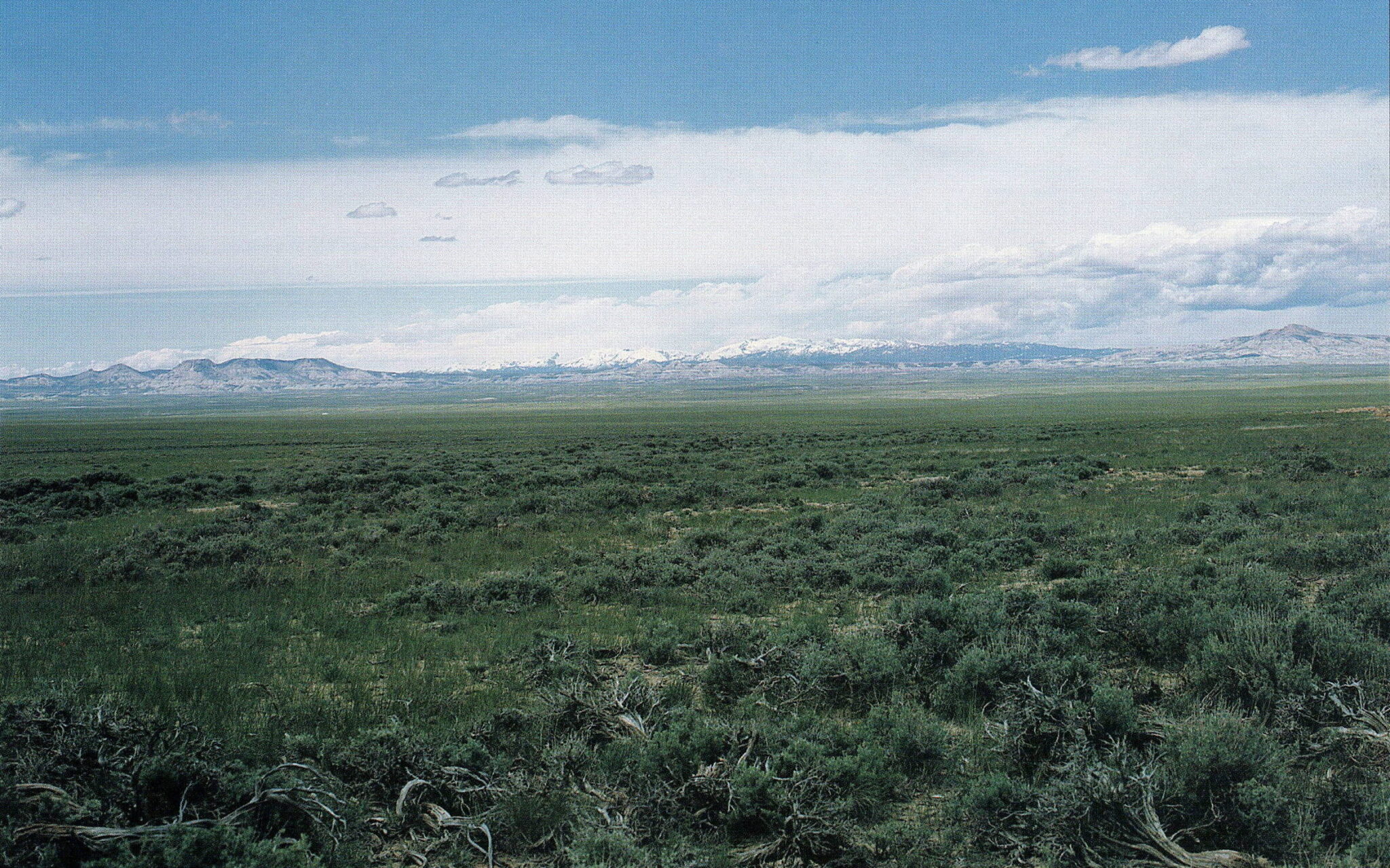
Sagebrush is a common name applied to any of twenty-odd related aromatic, bitter shrubs distributed throughout the semiarid regions of the United States. Scientists theorize that, during the last Ice Age, seeds from relatively low-height, woody plants were brought to this continent by way of the winds, or on the coats of animals migrating over the Bering Strait from Asia. Some species of sagebrush, however, are believed to have evolved here in North America.
Sagebrush is native to the plains and mountains of western North America. Sagebrush country is as vague a term as “The Great American Desert” in which this dry terrain is found. Neither tract of ground has set boundaries, nor can it be plotted exactly on a map. Accounts recorded by early explorers noted that the Great American Desert began after they crossed the Missouri River and extended west to the Rocky Mountains and beyond, all the way to the Sierra Nevada range. This vast area now occupies millions of acres in portions of a dozen western states.
The land on the eastern edge of this flat, treeless expanse was cultivated by the wave of immigrants as they moved westward in the 1800s, making that region a very productive cropland. But as immigrants traveled further west, the great desert became more variable, ranging from sandy plains to alkaline flats to rugged rock formations and steep mountain slopes. The nature of the soil was either deep and fertile or shallow and rocky.
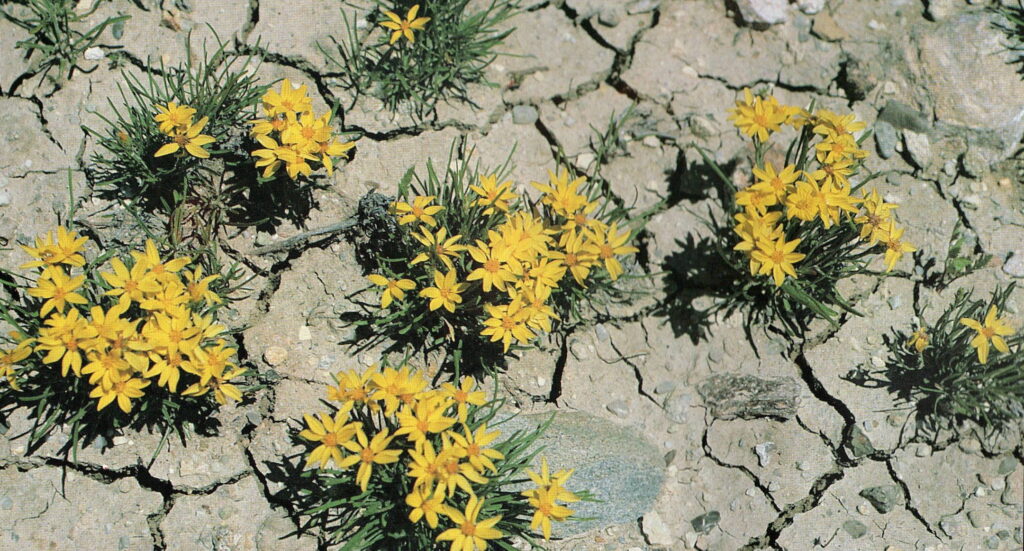
Variable in climate, topography, and species, the single most important unifying characteristic over this broad region is the presence of sagebrush, usually conspicuous and often a major dominant. Sagebrush is well adapted for the long, cold months of winter as well as the hot, rainless summers of this region.
Since water is the major limiting factor of plant growth and reproduction in sagebrush country, the plants have evolved a combination of adaptations which enable them to cope with the drought conditions. These adaptations are numerous and varied. Some enable plant tissue to undergo extreme dehydration without permanent cell damage, others make it possible for the plants to extract water from reservoirs deep beneath the earth’s very dry soil. Furthermore, sagebrush becomes somewhat dormant during the dryer part of the year, giving the impression that the plant is dead, thus conserving water. Occasional thunderstorms drench the cracked soil and rejuvenate the dormant plant life. Adaptations leading to drought tolerance are physiological in nature and are typical of desert species.

Sagebrush thrives in elevations of about 1,600 feet to nearly 11,000 feet. Within the sagebrush family, species range from the more dominant (those plants that exert the greatest influence due to size and/or density) and subordinate (simply associates.) Tall sagebrush is the most widespread, the most common species in the United States. A similar species, the low sagebrush is also abundant in the plains of North America. Generally, sagebrush grows from one to eight feet in height. Most varieties of sagebrush have a gnarled, woody trunk at or near ground level, with many upright branches rising from the base.
Sagebrush has a period of rapid growth which begins in late winter and spring. The plant produces food for a variety of wildlife very early in the spring, when moisture is abundant. Sagebrush is a deciduous, long-lived, evergreen, shrub that produces two sets of silvery, gray-green leaves each year. The small flowers of sagebrush are produced during late summer or early fall in clusters of numerous, yellowish heads.
There is a strong, distinctive odor to sagebrush that is secreted from the granular hairs on the leaves. The volatile chemicals which are responsible for the strong sage odor may have an allergenic effect on some people, which is further aggravated by the slow-producing flowering period. The release of the toxic compounds from the shrub’s leaves inhibit the germination and growth of many would-be competitors.

Sagebrush itself extends well beyond sagebrush steppe. These prolific plants pollinate by wind and today dominate millions of acres of the American West. A proportionate increase in the growth of sagebrush has also been enhanced due to grasses being depressed under heavy grazing conditions. These grazing practices deplete the forbs and perennial grasses that compete with sagebrush which makes the plant even more prolific.
For numerous years, range managers have worked to restore vegetation to the land. They have eradicated sagebrush by selectively burning (which causes complete top-kill of the plant), spraying, plowing or dragging huge chains over the terrain, knocking down the shrubs but leaving the forbs and grasses. To increase the density of the grasses, species of grasses that bear up under heavy grazing, are usually planted in place of sagebrush. These vegetation restoration programs have led to increased use of the rangeland. However, a single sagebrush can produce thousands and thousands of seeds in a year and as part of the natural succession of plants, sagebrush frequently prevails and takes the area over once again.
With all the defenses the sagebrush has had to adapt for its own protection, there are grasses and plants that do co-exist with this dry, woody plant. During the springtime, when sagebrush is most colorful and fragrant – and also in the fall – many varieties of grasses, cactus and wildflowers flourish alongside the sagebrush and brighten the open prairies. In a dry year, however, many plants bloom only briefly or not at all. This region, as harsh and desolate as it appears, is nevertheless dependent upon water.
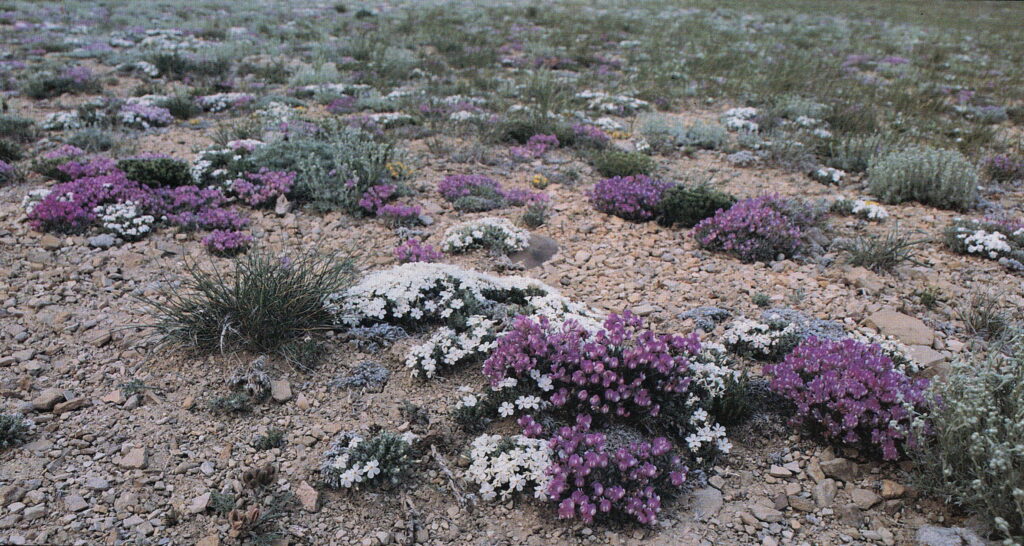
Today, scientists are trying to determine if sagebrush can be an alternate crop. Studies are being conducted on the economics and management practices needed to take advantage of the volatile chemicals found in the foliage of sagebrush. Cooperative research has found that sagebrush can be an effective fumigant for controlling insect pests in stored grain. Laboratory studies have confirmed that there are no residual effects on the quality in the flour, volume or taste of bread made from the flour of treated grain.
Scientists are also working on a solution for utilizing sagebrush terrain as grazing land for both cattle and a variety of wildlife who have similar feeding needs. Researchers are experimenting with varieties of sagebrush found in the desert plains and have bred new plants for palatability and for high protein content. Field tests are being conducted for its use and botanists are hopeful that commercial plant breeders will eventually market the seed to range managers.
If these scientific experiments are successful, and these new efforts put into practice, sagebrush will no longer be considered troublesome by ranchers and range managers. It will convert sagebrush into a valuable crop for the dry terrain of the open prairie.
Prairie Ghost of Sagebrush Steppe
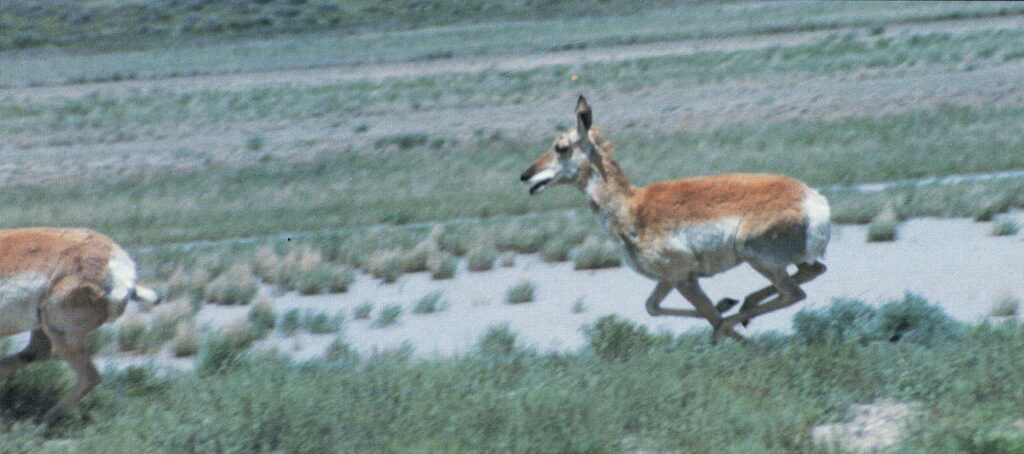
Although plant life ranges from grasslands to forests, mountain meadows and alpine tundra, the term “sagebrush country” is often applied to the State of Wyoming as sagebrush steppe covers many areas of the state. One such region lies east of St Stephens Mission. This terrain appears to be a wasteland to a passing traveler, who recalls seeing miles and miles of sagebrush and fleeting herds of pronghorn antelope.
The pronghorn antelope isn’t the only wildlife inhabiting this open prairie, but it is a fairly common sight throughout the area and is well suited to the dry rangeland. Although sagebrush isn’t palatable for most varieties of hoofed mammals who are unable to digest the plant, pronghorn antelope make heavy use of the shrub; they also feed on grass and cactus. Being highly mobile, the pronghorn may cover a large area during a year when food is sparse.
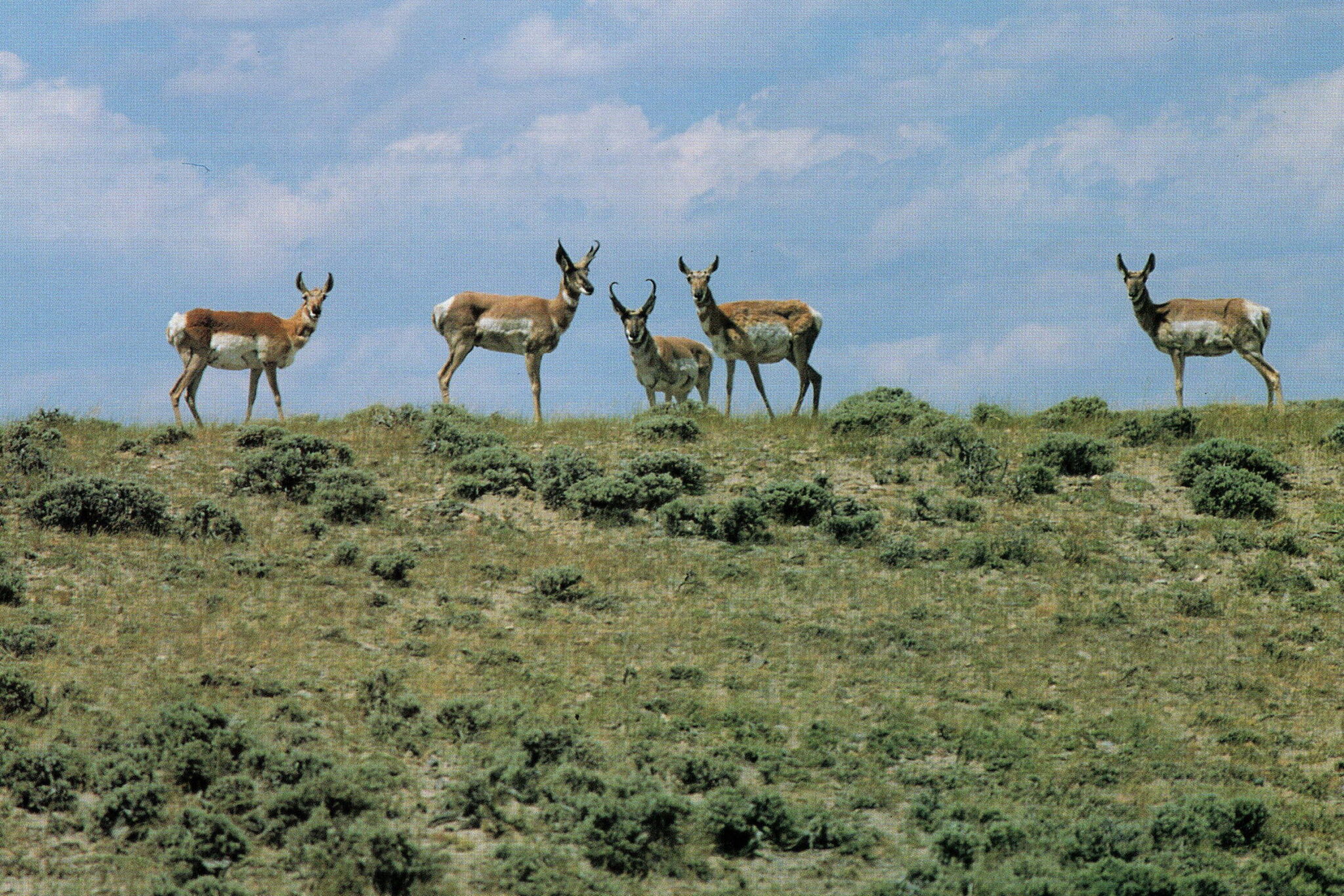
The pronghorn antelope is a true American native and is found only in North America. They have roamed the plains and deserts of this continent in their present-day form for the last million years. It is a unique animal, as it is the lone member of its family, “Antilocapra Americana,” which means the “American goat-antelope.” However, there are no true antelope in North America and the pronghorn is neither antelope nor goat. The pronghorn derives from its own species that has been evolving on this continent for 20 million years.
The coloration of the pronghorn varies from light tan to a rich, reddish-brown on its back and sides with two white bands on the throat and white patches under the stomach and on the rump. The hair on the thick mane of the neck is dark brown to black in color. Features that distinguish the male from the female are the male’s black cheek patches below the eye, the black mask extending back from the nose and its black horns. Both sexes have horns, rather than antlers. The female’s horns are small spikes, while an adult male’s horns can reach 20 inches in height. Pronghorns are the only animals in the world who shed their horns annually. The outer sheath is shed in the fall and has grown back by the following summer.
Due to its light coloring and its ability to reach speeds of 60 miles per hour, the swift pronghorn is often referred to as the “prairie ghost” or “phantom of the prairie.” The pronghorn can easily outrun any other animal in pursuit and are known for covering long distances at 30 to 40 miles per hour. The pronghorn is the fastest North American mammal.
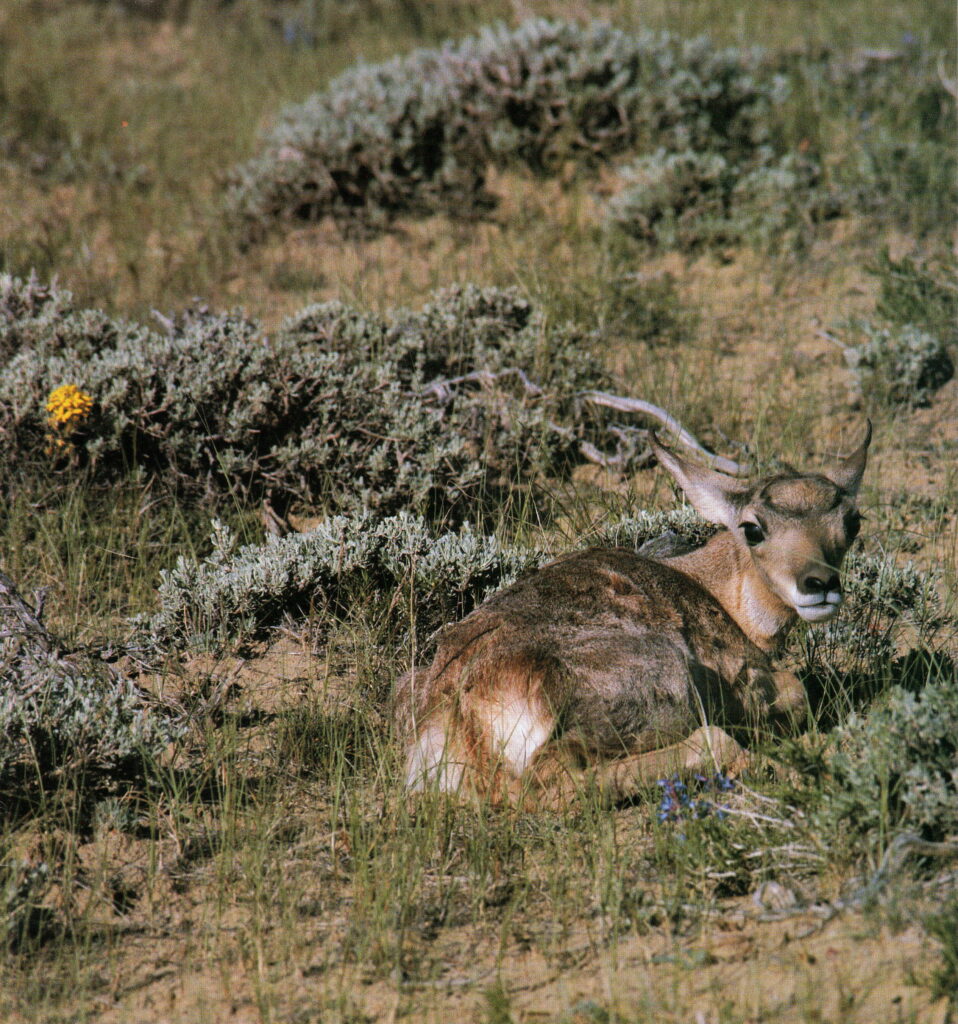
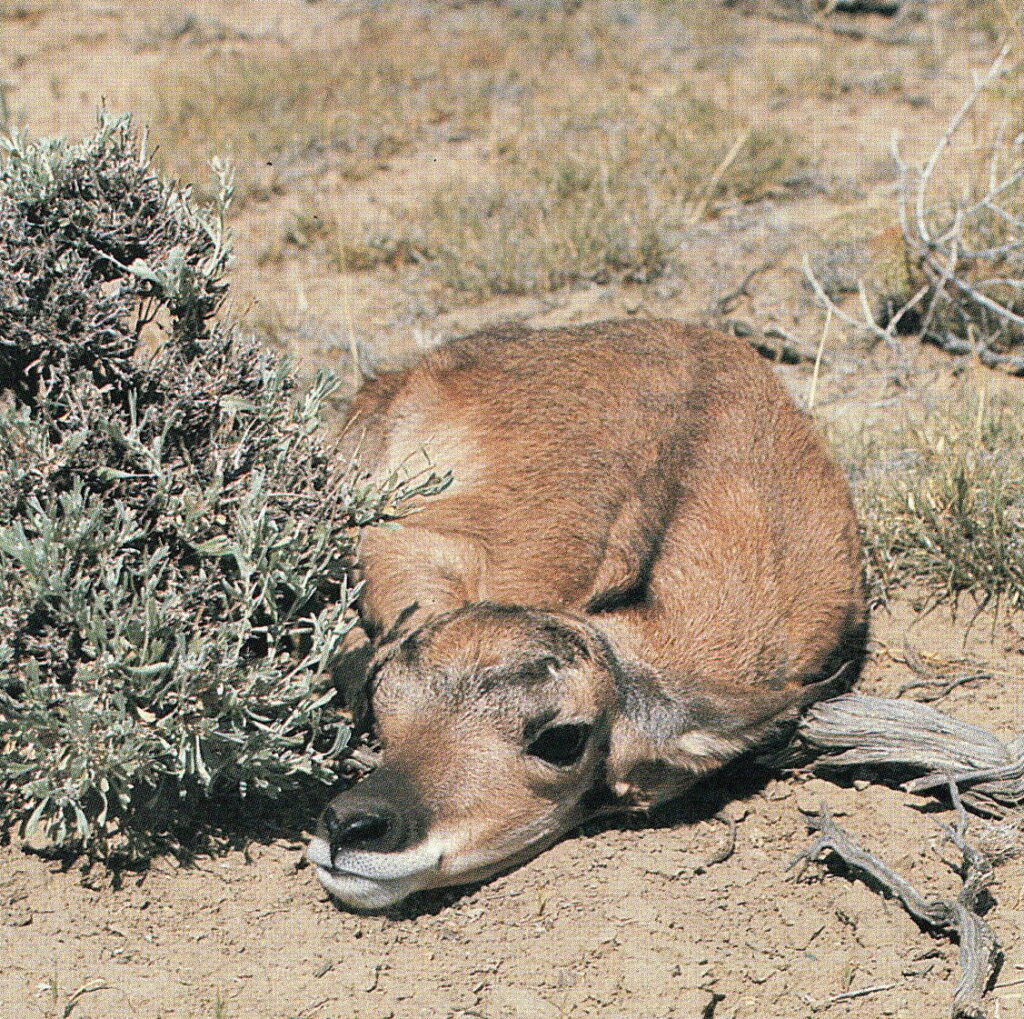
Nature has provided the sleek pronghorn with the perfect defense: extremely keen wide-angle vision, remarkable hearing and great sense of smell. Presumably, sentinels within the herd stand guard when the group is grazing or resting and alert the herd of approaching danger. In times of danger, the pronghorn has the unique ability to signal the herd in bright sunlight by erecting the white hair patches on its rump to produce a white flash that can be seen for many miles. The lead female responds to danger by quickly guiding the herd to safety.
In the early 1800s, the pronghorn population may have numbered nearly 40 million at one time, which would have made it as abundant as the American bison. Some of the earliest accounts of the northern plains and its habitat were recorded by Meriwether Lewis and William Clark on their Westward Expedition of 1804-06. They reported seeing large herds of both antelope and bison and their summation numbered in the millions.
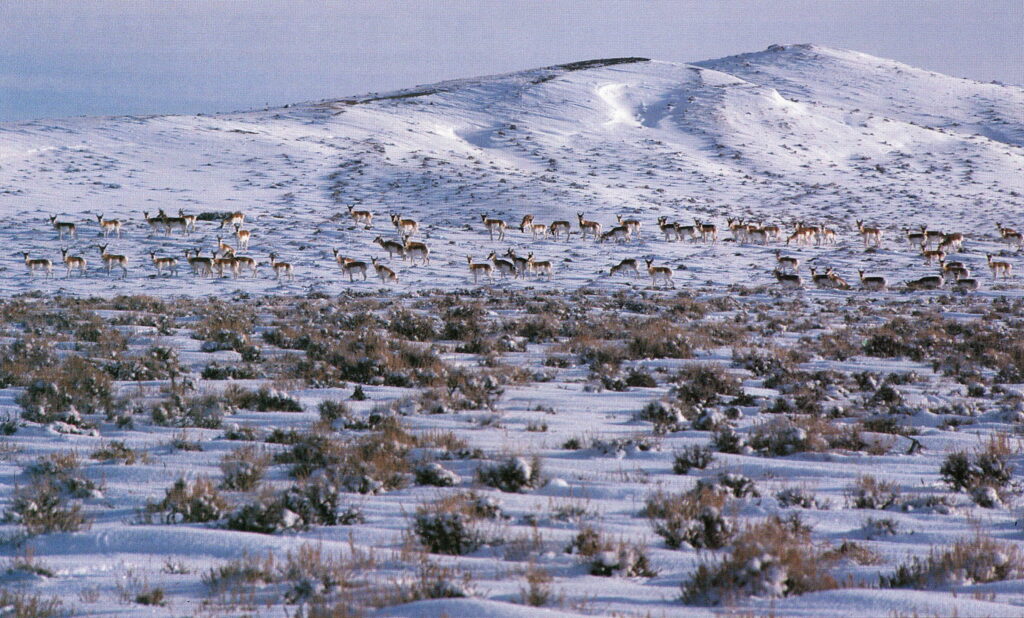
Between 1840 and mid-1880, hide and meat hunters nearly exterminated both the bison and the antelope. While buffalo were mainly harvested by market hunters for their hide, the much smaller pronghorn were harvested to feed railroad workers, miners and the ever-increasing invasion of immigrants moving through the sagebrush country westward. Due to overhunting, the pronghorn were estimated to be as few as 15,000 by the 1920s.
Today, bison are increasing in number as a result of private buffalo ranches throughout the United States. Currently, nearly one million pronghorn are roaming the rangeland of sagebrush steppe due to conservation and competent wildlife management.
A Variety of Wildlife and Vegetation
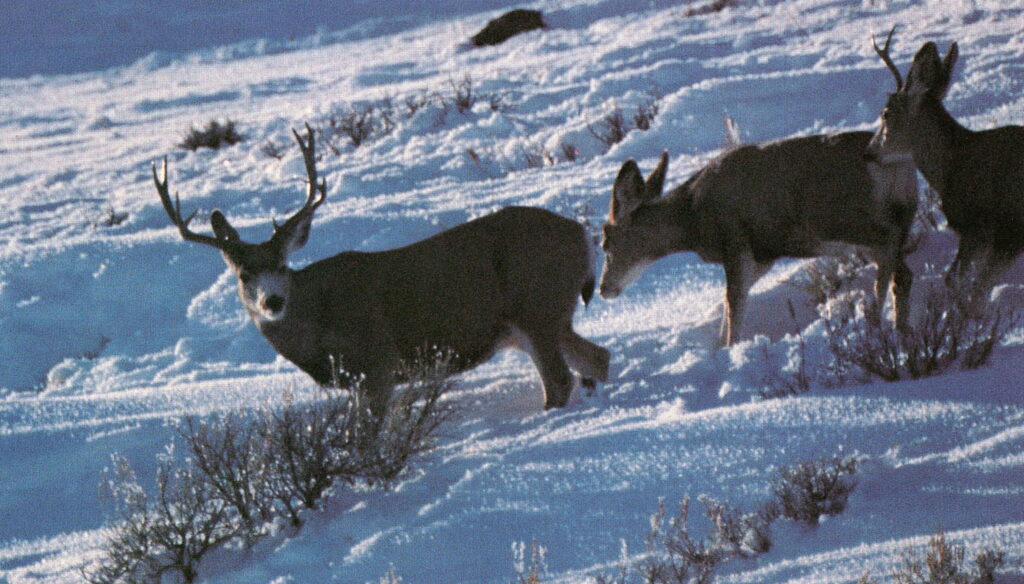
The impressive adaptations that wildlife and vegetation of the sagebrush steppe have undergone, enabling them to withstand the extremes so typical of this semiarid region, provides a real beauty for those who seek it. Although they are the most prominent, sagebrush and pronghorn antelope aren’t the only plant and animal found in this vast area.
In addition to various grasses and cactus plants, there are patches of beautiful wildflowers blanketing areas of sagebrush country. Mule deer, foxes, coyotes, badgers, jackrabbits, cottontails, and rodents, to name a few, are all inhabitants of this wide-spread prairie.
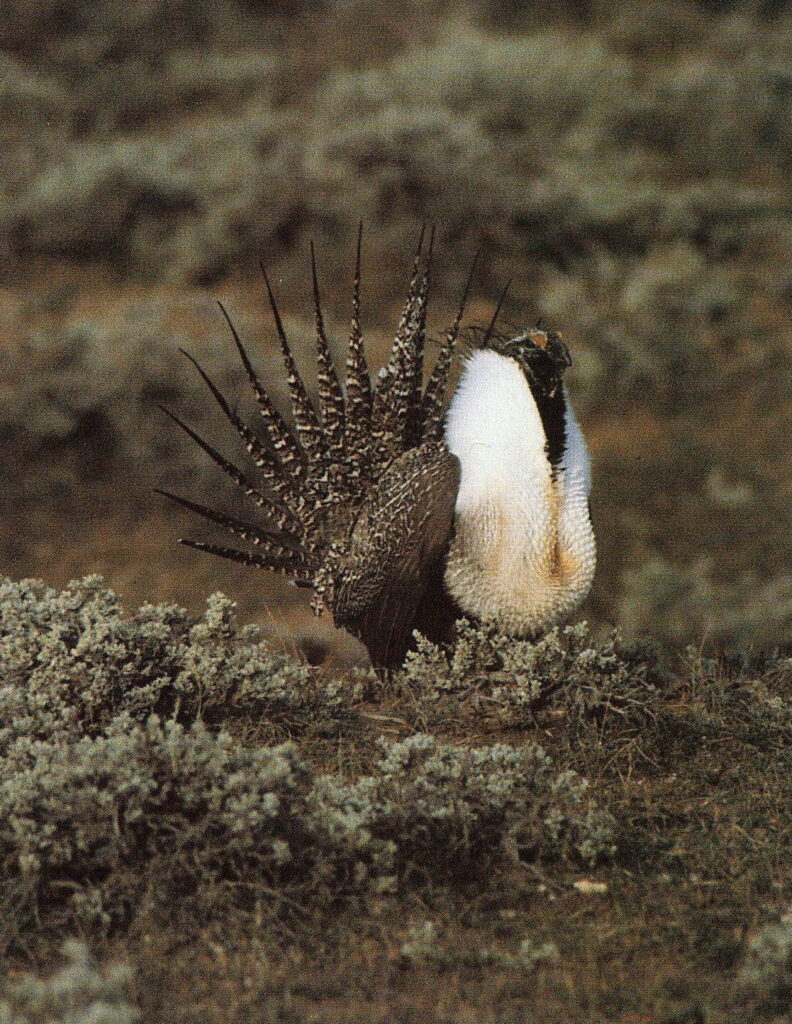
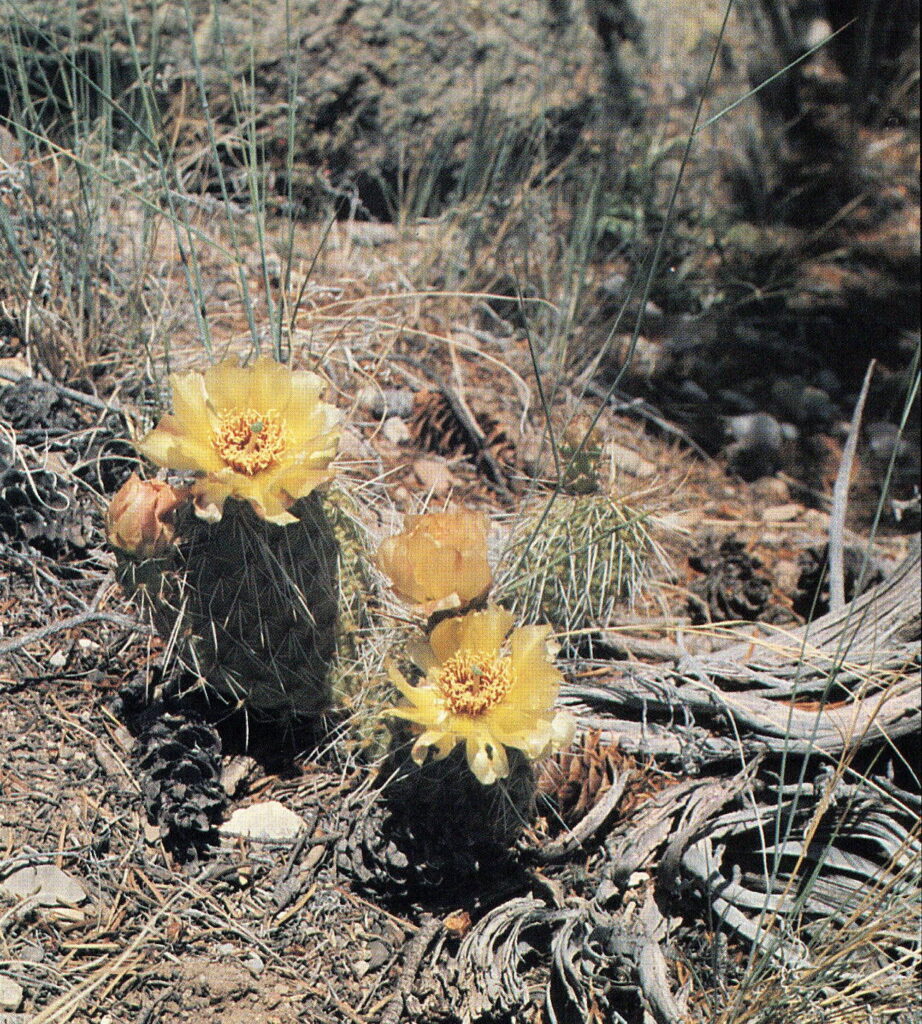
The sagebrush provides 80 percent of this region’s nesting habitat for songbirds who nest among its branches. Sagebrush also provides protection for a variety of wildlife. One such creature is the sage grouse, a game bird who has a diet of nothing but sagebrush leaves from October to April. Sage grouse build their nests under or near sagebrush. In the spring, when their eggs have hatched, the sage grouse lead their flightless chicks on foot to food and water. Utilizing sagebrush as a cover from predators, these precarious back-and-forth trips from the nest are much safer journeys.
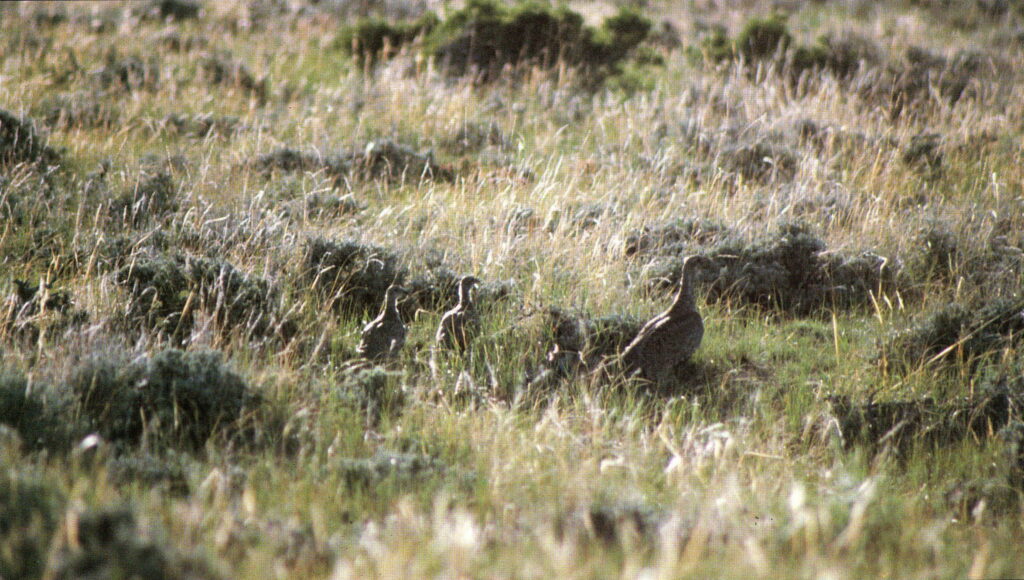
Another animal inhabiting the sagebrush steppe is the badger who is easily recognized by a white head with a black stripe over each eye and ear. They have poor eyesight, but have excellent hearing and a keen sense of smell. They live in underground tunnels that normally have several entrances. Their bedding materials are made up of collected grass and leaves. At the end of winter the nest is scraped out and dumped outside making way for fresh new bedding.
Badgers are territorial animals with strong bodies that measure from 16 to 28 inches long. Their short, powerful legs end in long, heavy-clawed feet useful for digging into burrows of ground rodents, which is one source of nourishment in their diet.
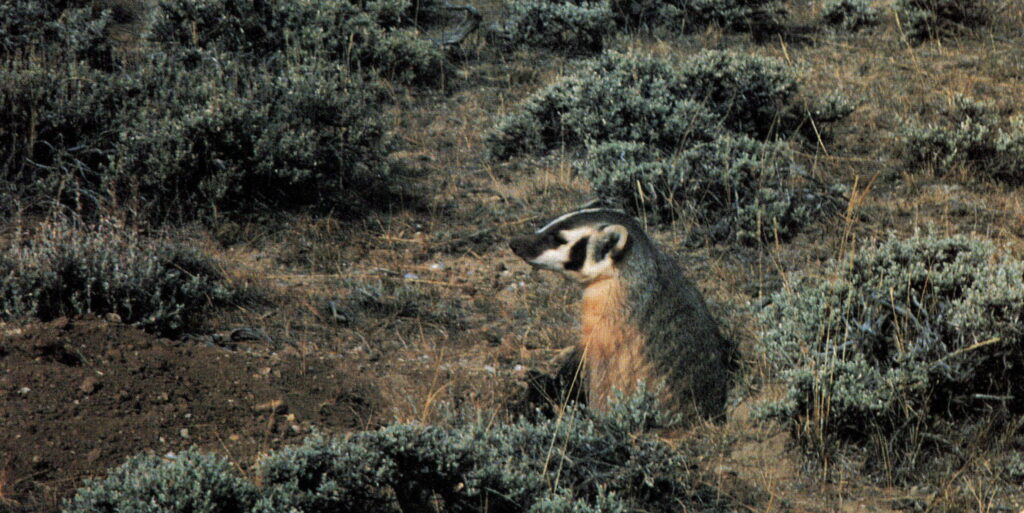
A well-known animal on the open plains is the wild horse. Scattered herds of these magnificent animals roam this rangeland just like the original Spanish horses did many generations ago. Plains Indians gathered these wild mustangs and through gentle patience and tireless efforts, trained their new acquisition for several tasks: to pull a travois used for transporting their possessions; to carry loads; and to carry a rider into combat or into thundering herds of buffalo during a group hunt. These mustangs, brought to this continent by Conquistadors, greatly enhanced the lifestyle of the Plains Indian.
The wild herds of today are not all descendants of the Spanish mustangs. Many are untamed horses from ranchers’ stock that have eluded their owners and bred themselves into sizeable herds. Their thick, flowing mane and tail are their trademark. The heavy build of their body distinguish them from many of the domestic breeds found in local stables.
Wild horses are aggressive about their freedom. They are very strong, high spirited animals. Watching them race across the outstretched rangeland is a thrilling experience. Wild horses have a basic instinct to avoid human contact. But periodically, to thin out the various herds, wild horse roundups are conducted by the government and can be acquired through the Adopt-A-Horse program. To gentle one of these horses is exciting, challenging and rewarding.
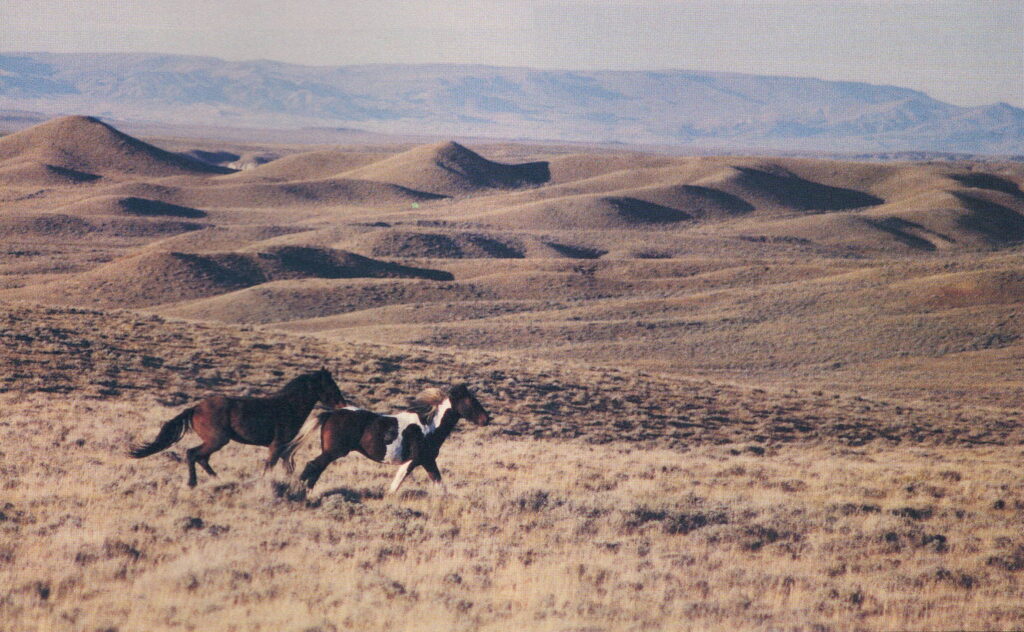
Small game animals such as the cottontail rabbit are also found in sagebrush country. The cottontail, whose name comes from their round, fluffy white tail, are North America’s only native rabbit. Here in Wyoming, their habitat can range from mountains and foothills to the more open, sagebrush and desert areas of this region.
The cottontail has a grayish-brown body with a sprinkle of black and white on the back and a sprinkling of white on the forehead. Cottontails use sagebrush, with its tangle of branches and leaves, for a haven to hide from eagles and other predators. The cottontail is the most widely found and most hunted small game in America.
Fur-bearing animals like the red fox also inhabit this dry prairie region. Generally, they live in burrows and are most active at night. The coloration of the red fox is usually rusty with black legs and have a white tip on their bushy tail. In the spring, parents carry food to the den where the young are raised until the kits are able to search out food on their own.
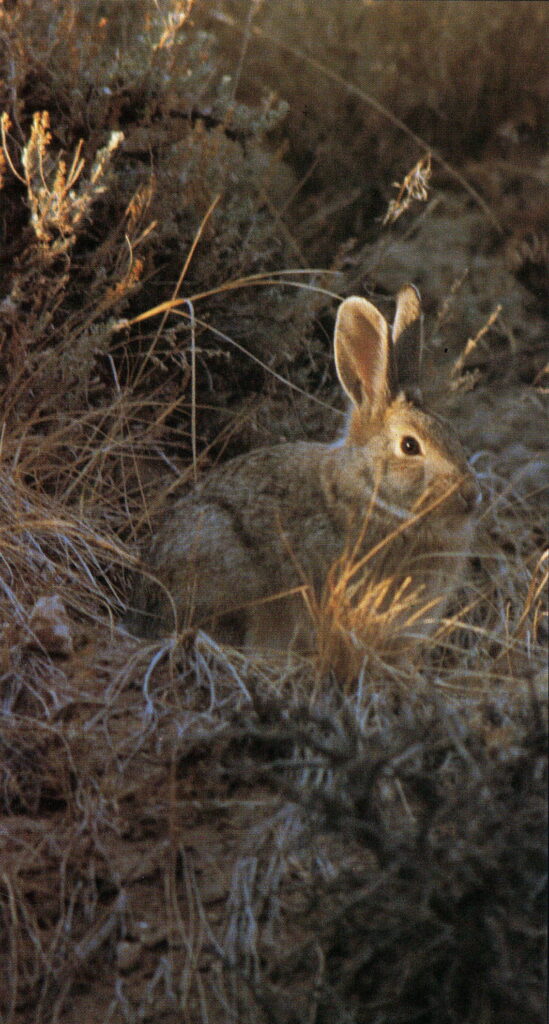
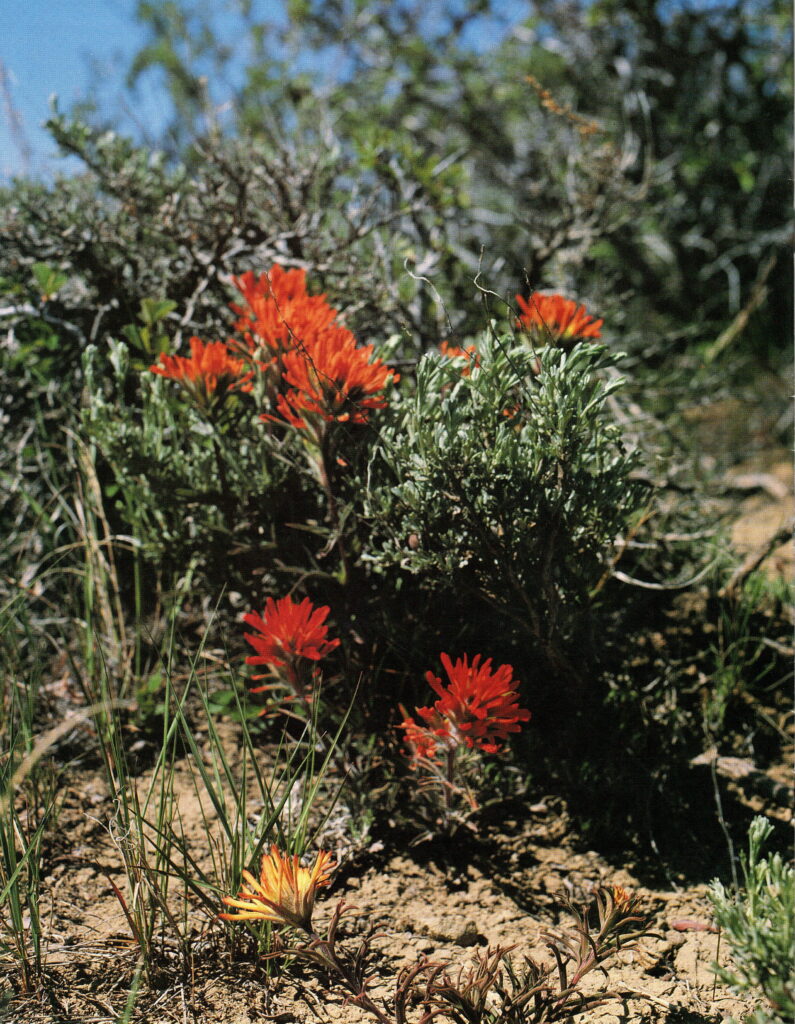
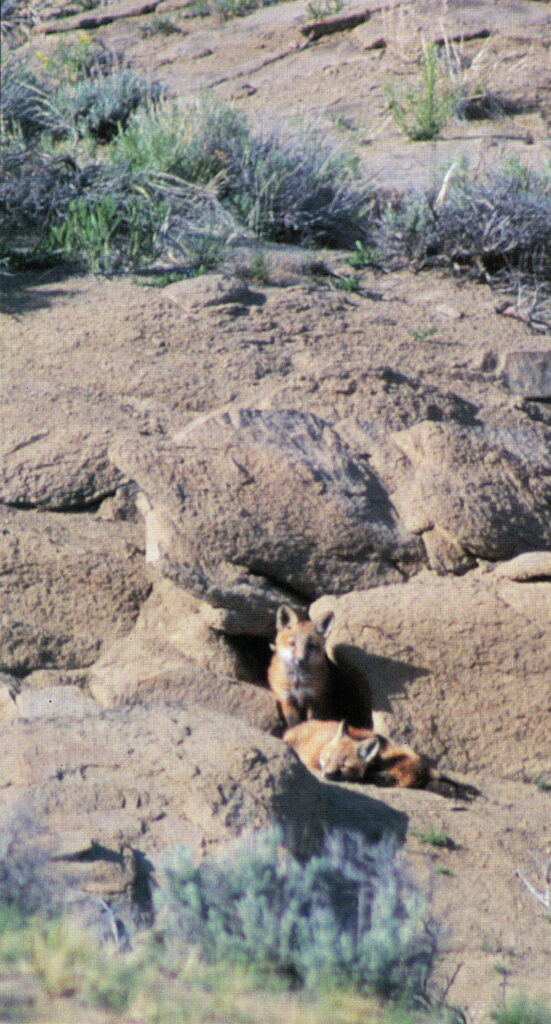
The cunning behavior of a fox helps it outsmart hunters and protect it from predators. Their sly, craftiness also yields the fox with a variety of small animals and insects to help make up their diet. Another kind of fox found in the open prairie and desert country is the kit fox. However, this small sandy-colored fox is rare.
Coyotes are abundant and are widely-known animals in the West. They are curious, but have a keen instinct for survival. Coyotes have evolved to survive their environments and humankind.
The sly coyote, or “little wolf” as some Native Americans call it, is the topic of many Indian legends. They have long soft fur, which is usually tawny-gray in color, with a large bushy tail. Coyotes roam over their range, which usually consists of no more than 10 or 12 square miles, to locate food for their insatiable appetite. Heavy snows will usually drive them to lower elevations. They are good hunters and hunt both day and night. Their diet consists of small animals, fish and fruits and berries of wild plants.
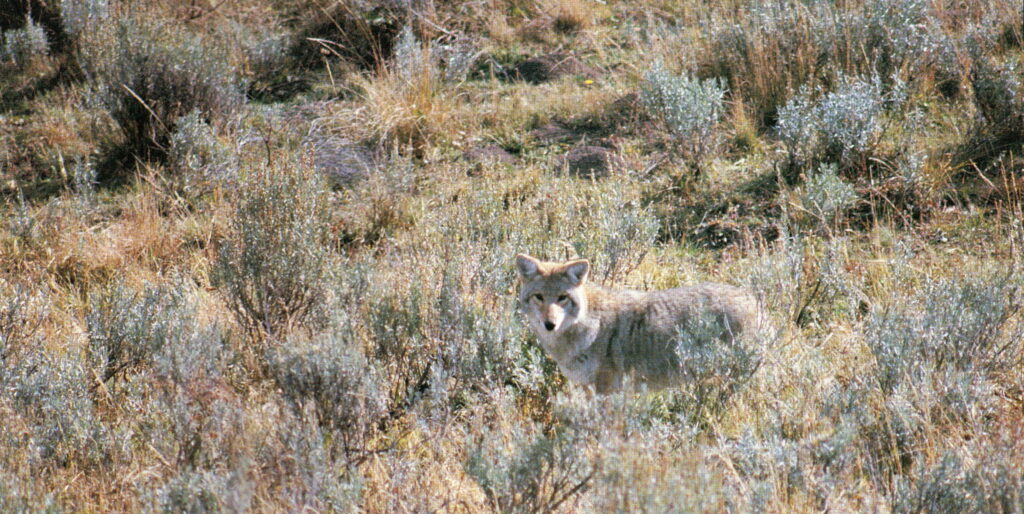
Although the coyote usually digs its own den, sometimes it will enlarge an old badger hole or take over a cave in a rocky ledge. Some coyotes live solitary lives, but usually they favor a family group. The female coyote has one litter a year, usually in April or May, and both parents hunt to feed their young.
Coyotes have a good sense of smell, vision and hearing. Their howl at night is spine-tingling. Their quivering cry, accompanied with a high-pitched yapping, is often heard in the sagebrush steppe.
Just a few of the many varieties of wildlife and vegetation found within this secluded area were presented here. The fauna and flora of this sagebrush country provide real beauty for those who seek it.
St. Stephens Indian Mission Foundation is a non-profit organization, incorporated under the laws of the State of Wyoming on March 31, 1974, and listed on page 184 of the 1993 OFFICIAL CATHOLIC DIRECTORY. The sole purpose of the foundation is “to extend financial support to St. Stephens Indian Mission and its various religious, charitable and educational programs and other services conducted primarily for the benefit of the Northern Arapaho and Eastern Shoshone Tribes on the Wind River Indian Reservation.”
